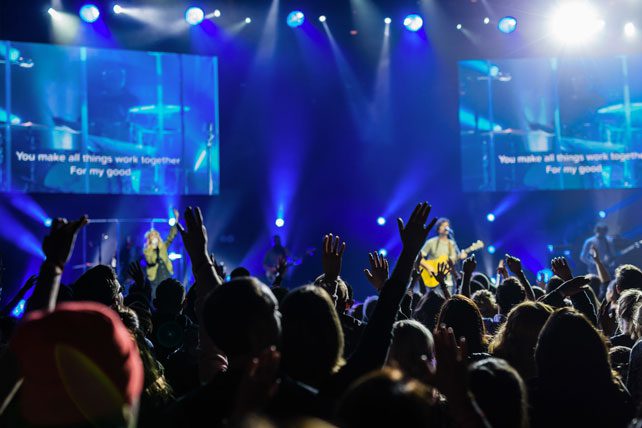It’s often assumed that the ministry of onscreen multimedia in a church is merely a task of sharing information. Announcements, sermon points, worship song slides — you need to make them large enough to read, spellcheck your work and, if possible, make it look pretty. But what if there’s something more? A deeper calling we’ve been given to tell a better story?
As a visual worship leader, I see the role of delivering onscreen multimedia similar to the role of other worship leaders or teaching pastors. We’re helping to shape a communal experience where we share God’s story in creative, multisensory ways that impact us in body, mind and soul. We are the sacred visual artists of our day, echoing the role played by cave carvings, stained-glass windows, icons and tapestries, revealing the story of our faith to both the seeker and the learned.
Visual Theology and Worship Song Slides
In light of this, it is imperative that we take a deeper look at how we use worship song slide to fill these digital canvases. Just as songs and teachings speak volumes about the hearts of worship leaders and teachers, the multimedia we display reveals our hearts. It shares our visual theology. It teaches others about the character of God and our relationship to him.
To further explore this idea of visual theology in worship song slides, let’s look at one of the basic ingredients of on-screen multimedia: the text. Specifically, the way we use text during a worship experience to encourage easier participation and to tell a better story. Here are a few ideas to consider:
Poetry & Punctuation
Song lyrics are, at their core, poetry. Their use of metaphor, rhyme and phrasing are set apart from the formal constructs of proper sentence structure. So let’s allow this knowledge to free us from the constraints that so often prohibit us from telling a better story. You’ll also find this helps when leading songs unfamiliar to your community, since musical notation is most often not included onscreen.
• Line breaks are excellent guides for phrasing
• Commas in the middle of a line help with phrasing
• Commas, periods, semicolons at the end of a line are unnecessary clutter
• Use quotation marks when someone is being quoted
• Don’t forget to include question marks
Capitalization in Worship Song Slides
“Why didn’t you capitalize the word ‘I’ in that song?” I love that question, because it’s the beginning of a beautiful dialogue about our relationship to God. Capitalizing the words “I” and “God” are quite common. We see examples of this in every book or article we read. However, when we see poetic text that uses a lowercase “I,” it can be unsettling.
“I wish they would proofread their song lyrics.”
“There they did it again!”
“Wait – every ‘i’ is uncapitalized. And the first word in each line is too.”
“Well, at least they capitalized the name of God.”
“Oh, and they capitalized ‘Joy’ and ‘Life.’ That’s cool.”
This uncomfortable inner dialogue is pondering one meaning of what I believe John is getting at when he says, “He must increase in importance, while I must decrease in importance” (Jn 3:30). It is a constant reminder of our relationship to God, the Father, Creator, Master, Teacher and Lord of our lives. He alone gets the glory and the fame, while we are simply his hands and feet.
In addition to the spiritual, worship song slides can also serve a practical purpose. With so many songs written from both the human perspective and God’s perspective, it can become confusing to understand exactly what we’re singing. Capitalizing only the names and metaphors for God helps us to properly orient ourselves in the text.
The Word & The Visual Canvas
In addition to displaying song lyrics during a worship set, our church has started to display Scripture right in the middle of a song. Since many of today’s popular worship tunes include space for energetic guitar solos or quiet reflection, we have started to use Scripture and visual liturgy films to fill that space, creating a link between a lyrical theme and a Bible passage.
Often this helps directly reinforce the theme of a song, provide thematic harmony, or create dissonance, using passages and visuals that cause us to celebrate or struggle with the truths we’re experiencing onscreen. Pulling this off requires collaboration between the worship team on stage and the visual worship leader, but the end-result is often one of the most memorable of the day. Great examples of visual liturgy are being created by Travis Reed and The Work of the People (www.twotp.com).
Nate Ragan is Director of Product Development at MediaComplete, makers of MediaShout presentation software. Nate is also part-time staff as a visual worship leader and creative at Rolling Hills Community Church in Franklin, TN.












